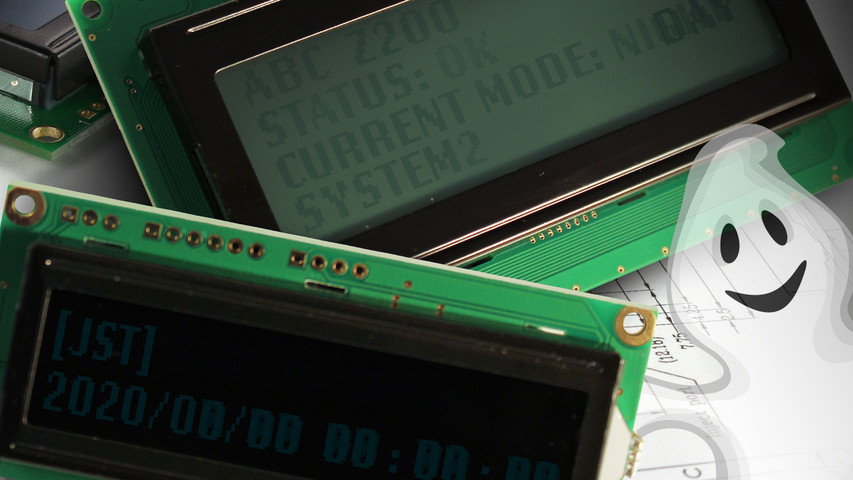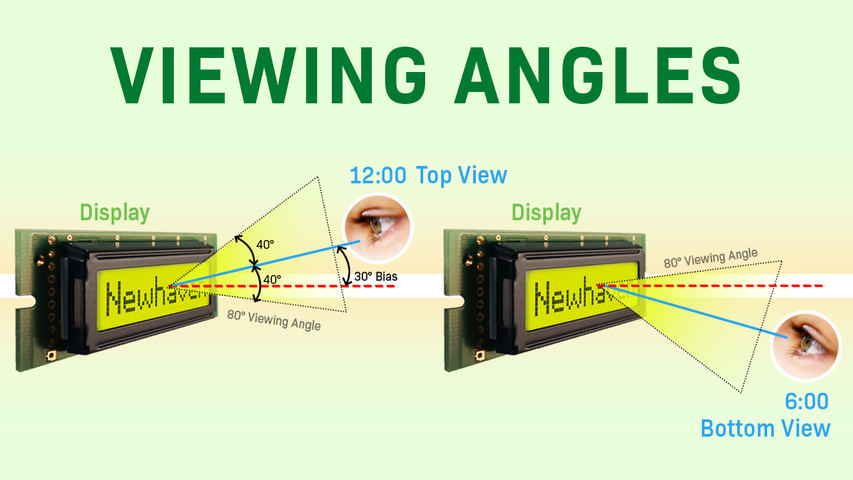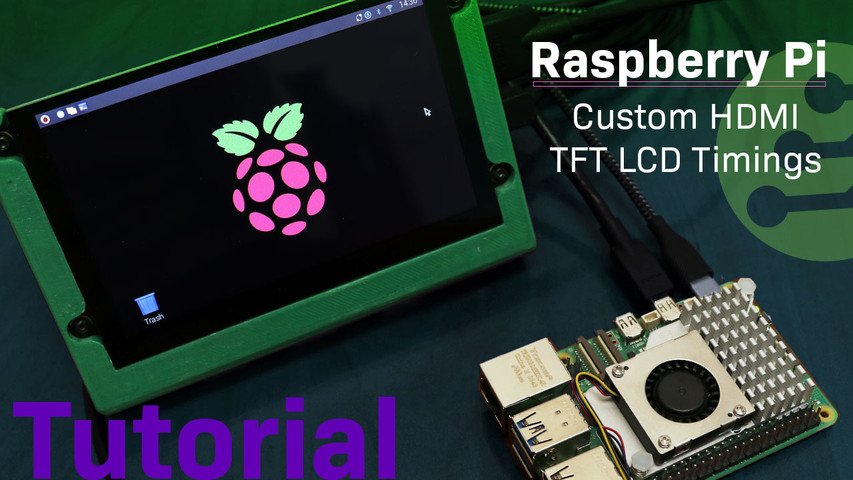Screen Burn-In
Image burn-in affects all screen displays, including LCDs and OLEDs in mobile phones, monitors, wearable devices, televisions, and all electronic devices with a display screen. This article will cover everything you need to know about image burn-in and ways to mitigate it.
Oto czego dowiesz się w tym wpisie:
What is Screen Burn-in?
Screen burn, also known as burn-in, occurs when a persistent image leaves a permanent ghost-like imprint on a display. While this issue is most commonly associated with OLED (Organic Light-Emitting Diode) displays, LCDs (Liquid Crystal Displays) can also experience a form of temporary image retention called image persistence. Understanding how different display technologies respond to prolonged static images is crucial for engineers designing applications in industrial, medical, and commercial environments.
Powiązane: Co to jest wyładowanie elektrostatyczne (ESD)
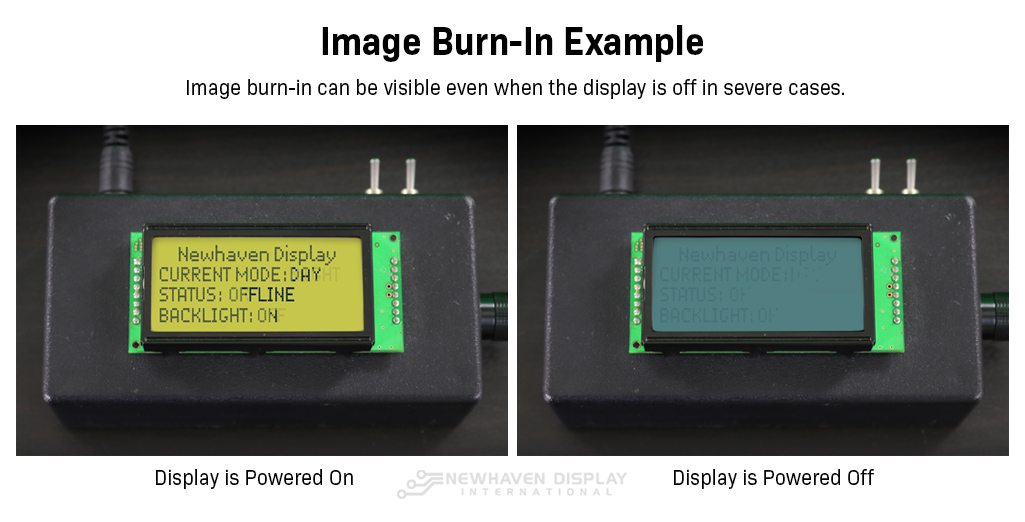 Przykład wypalenia obrazu na LCD.
Przykład wypalenia obrazu na LCD.
Burn-In a retencja obrazu
Chances are you've encountered image burn-in and image retention before, but you didn't know which one you were seeing. They both have the same visual effects, so it's easy to mistake them for each other, but there's one key difference: image retention is temporary, and image burn-in is permanent.
We've seen many misleading articles, videos, and guides about "fixing" image burn-in or removing it from a display. Image burn-in is completely irreversible once it occurs on your display screen.
W większości przypadków przewodniki te wyjaśniają, jak działa retencja obrazu i jak można przyspieszyć proces jego odzyskiwania. Chcemy wyjaśnić wszelkie niejasności, jakie mogą się pojawić w związku z wypalaniem i zatrzymywaniem obrazu na wyświetlaczach LCD i OLED.
Zachowanie obrazu
Retencja obrazu, znana również jako ghosting lub image persistence, to tymczasowy efekt pozostawania obrazów widocznych na wyświetlaczach LCD lub OLED przez krótki okres, zwykle kilka sekund.
How to tell the difference between image retention and screen burn-in?
Jeśli obrazy zanikają po krótkim czasie, masz do czynienia z tymczasowym zatrzymaniem obrazu. Jeśli obrazy pozostają na stałe, masz do czynienia z wypaleniem obrazu.
Image retention doesn't require any intervention from the user to make it go away – it'll do that by itself. Retention will often occur before burn-in does on newer display technology like our TFTs and our new IPS displays.
Powiązane: Co to jest wyświetlacz IPS?
Image retention will fade away, but there are some tips you can use to speed up the process. Simple actions like using a screen saver, cycling various graphics on the screen to exercise the pixels, and powering off the display whenever possible will help clear the image retention on your display.
Są to te same sztuczki, które są reklamowane jako "lekarstwo" na wypalenie obrazu, ale nie daj się zwieść. Nie ma lekarstwa na wypalenie, są tylko sposoby, by je przedłużyć.
Zanim założysz, że Twój ekran jest uszkodzony przez wypalenie, wypróbuj te wskazówki i poczekaj, aby sprawdzić, czy to tylko zatrzymanie obrazu. Zatrzymanie obrazu jest nieszkodliwym i powszechnym zjawiskiem na wielu ekranach.
What Causes Screen Burn-in?
Screen burn-in is caused by screen pixels that stay activated in a static position for long periods of time. Think of a TV in a lobby or waiting area that's always playing the same news channel. The news channel footer and logo get burned into the screen permanently, even when you change the channel.
Do najczęstszych przyczyn wypalenia się wyświetlacza należą: statyczne obrazy, komunikaty, loga i ikony.
Na przykład w telefonach komórkowych wypalenie obrazu może być spowodowane stałym, statycznym położeniem baterii, ikony sygnału wifi i usług.
Kiedy piksele LCD lub OLED są aktywowane w statycznej pozycji, w końcu "utkną" w tej pozycji. Kiedy to się stanie, zauważysz wyblakły, uparty obraz, który utrzymuje się na ekranie.
Wypalenie na wyświetlaczach LCD i OLED
Rezultat wypalenia wygląda tak samo na wszystkich typach ekranów, ale sposób w jaki dochodzi do niego na LCD i OLED jest nieco inny.
Powiązane: Różnice między diodami OLED a LCD
Jak dochodzi do wypalenia w wyświetlaczach LCD
Po wyświetlaniu statycznego obrazu przez dłuższy czas, kryształy w wyświetlaczu ciekłokrystalicznym stają się słabsze i mają większe trudności z przejściem z pozycji całkowicie "ON" do pozycji całkowicie "OFF".
Gdy piksele nie aktywują się lub dezaktywują całkowicie, skutkuje to wyblakłymi obrazami, które nie chcą się usunąć z ekranu. Jest to częste w aplikacjach wykorzystujących znakowe wyświetlacze LCD, gdzie znaki alfanumeryczne są aktualizowane rzadziej.
Na poniższym przykładzie widać wyblakłe trwałe wrażenie tekstu pozostawionego na ekranie LCD po wyłączeniu wyświetlacza.
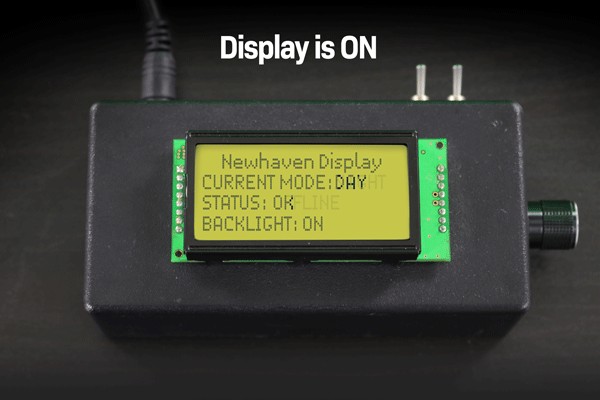 Przykład wypalenia obrazu LCD znaków przy włączonym i wyłączonym wyświetlaczu.
Przykład wypalenia obrazu LCD znaków przy włączonym i wyłączonym wyświetlaczu.
Jak dochodzi do wypalenia w diodach OLED
Diody OLED są wyjątkowe, ponieważ nie potrzebują podświetlenia, aby świecić. Każdy piksel na wyświetlaczu jest samoświecącą diodą LED, więc generuje własne światło. Jednak z czasem piksele nieuchronnie tracą swoją jasność. Im dłużej piksel OLED jest podświetlony, tym ciemniejszy będzie obok mniej używanych pikseli.
Jeśli statyczny obraz pozostanie na wyświetlaczu OLED wystarczająco długo, piksele pozostawią cień za poprzednim obrazem, nawet jeśli wyświetlacz pokazuje coś zupełnie innego.
Zobacz, jak tekst "Double Height" jest wypalony w OLED na poniższym przykładzie.
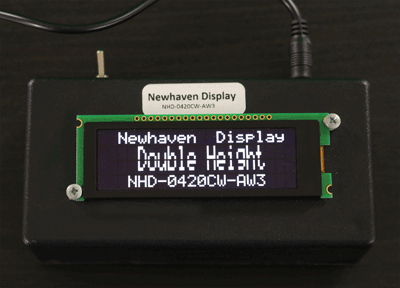 Przykład wypalenia obrazu OLED.
Przykład wypalenia obrazu OLED.
Pamiętaj: Nie ma sposobu na usunięcie lub zmniejszenie wypalenia po jego wystąpieniu. Jeśli uparty obraz utrzymuje się przez dłuższy czas lub po ponownym uruchomieniu monitora, prawdopodobnie masz do czynienia z wypaleniem obrazu.
Early Signs of LCD Screen Burn
LCDs don’t suffer from permanent burn-ins like OLEDs, but they can experience a temporary form known as image persistence. This occurs when a static image lingers faintly on the display even after the display content changes. Here are the early signs to watch for:
-
Ghosting or faint remnants of a previous image: If you can still see a shadow of a menu bar, logo, or other static content after switching screens, this is an indication of image retention.
-
Slow response time when transitioning images: If pixels take longer to refresh or adjust to new content, especially in high-contrast areas, your LCD may be experiencing early image persistence.
-
Color distortion in affected areas: Some parts of the display may appear slightly discolored or "washed out" after extended exposure to static content.
-
Variations across LCD types: IPS (In-Plane Switching) panels, commonly used for wide-viewing angles, are less prone to persistence than TN (Twisted Nematic) panels, which have faster response times but may exhibit minor retention effects.
If detected early, image persistence can be reversed by turning off the display or using a display refresh function. However, extended exposure to static content increases the risk of more stubborn retention.
LCD Applications Prone to Burn
While LCDs are less susceptible to permanent burn-in than OLEDs, certain industries rely on displays that frequently show static images, making them more prone to image persistence.
-
Medical Equipment Displays: Patient monitoring systems, diagnostic screens, and imaging devices often show static vital signs, graphs, or interface elements for extended periods, increasing the likelihood of image retention.
-
Industrial Control Panels: Factory automation screens, process control monitors, and instrumentation panels display static data, such as readouts and system statuses, for long durations.
-
Point-of-Sale (POS) Systems: Retail checkout displays and kiosks frequently show the same user interface for hours, leading to uneven pixel wear.
-
Automotive and Marine Displays: Navigation systems, dashboard readouts, and infotainment screens may hold the same map or gauge interface for long periods, causing temporary retention.
-
Test and Measurement Devices: Oscilloscopes, spectrum analyzers, and other laboratory instruments often feature fixed graphical elements, which can contribute to image persistence over time.
Newhaven Display’s TFT LCD modules are engineered with pixel-shifting technology, optimized brightness control, and advanced refresh techniques to minimize image retention. These design enhancements help extend the longevity and reliability of displays in mission-critical applications.
Early Signs of OLED Screen Burn
Unlike LCDs, OLED displays are more vulnerable to permanent burn-in due to their self-emissive pixels, which can degrade at different rates over time. Understanding the conditions that accelerate this process is essential for engineers designing long-lifespan products. Signs of OLED burn-in include:
-
Persistent ghost images: Static elements, such as logos or user interface (UI) components, remain visible even after switching displays, indicating pixel wear.
-
Uneven brightness levels: Frequently used areas may appear dimmer due to pixel aging, where some pixels degrade faster than others.
-
Color shifting or distortion: Affected regions may develop color imbalances, such as a reddish, yellowish, or bluish tint where burn-in has occurred.
-
Noticeable differences in high-contrast areas: Burn-in is most apparent where bright elements frequently overlay darker backgrounds, causing uneven luminance.
OLED Applications Prone to Burn
OLED displays offer vibrant colors and high contrast, making them ideal for many applications. However, certain use cases increase the likelihood of burn-in:
-
Medical and Diagnostic Displays: Patient monitoring systems and imaging equipment often maintain static readings and graphical elements.
-
Industrial and Automation Interfaces: Factory control displays frequently show persistent navigation menus and system statuses.
-
Handheld and Portable Devices: OLED-based test equipment, communication devices, and specialized tools often display static UI components.
-
Automotive and Aerospace Displays: Digital dashboards, heads-up displays (HUDs), and in-flight entertainment screens maintain fixed navigation elements and branding.
-
Retail and Commercial Signage: OLED advertising displays that feature static logos, pricing, or promotional graphics are at higher risk.
To mitigate OLED burn-in, Newhaven Display designs its OLED modules with pixel wear-leveling, automatic brightness adjustment, and built-in display refresh cycles. These features help extend the operational life of OLED displays used in high-contrast applications.
How to Test for Screen Burn
Detecting screen burn early can help prevent further pixel degradation. Here are a few methods to test for screen burn on LCD and OLED displays:
-
Full-Screen Color Tests: Displaying a solid color background (such as white, red, green, or blue) at full brightness can reveal ghost images or uneven pixel wear.
-
Gradient and Gray Screen Tests: Viewing a gradient pattern or a uniform gray background can help detect subtle color shifts, which may indicate early signs of burn-in.
-
Switching Between High-Contrast Images: Quickly alternating between bright and dark images can make burn-in effects more noticeable, especially in frequently used areas of the display.
-
Using Specialized Burn-in Test Tools: Some diagnostic applications generate test patterns designed to highlight persistent image retention or OLED burn-in.
If mild image retention is detected, running a pixel refresh cycle, adjusting brightness levels, or using a screen saver can help reduce visibility. However, permanent burn-in on OLED displays cannot be reversed, making proactive prevention the best approach.
Ways to Mitigate/Avoid Screen Burn-in
Nawet najbardziej zaawansowane wyświetlacze w pewnym momencie ulegną wypaleniu, ale istnieją pewne proste działania, które możesz podjąć, aby przedłużyć żywotność ekranu zanim nastąpi wypalenie. Dzięki odpowiednim praktykom, możesz uzyskać lata doskonałej wydajności swojego wyświetlacza bez żadnych efektów wypalenia.
How to avoid screen burn-in
- Wyłączanie zasilania wyświetlacza, gdy nie jest używany
- Użyj wygaszacza ekranu
- Ćwiczenie pikseli (efekt obracania lub przewijania)
- Zmniejsz jasność lub kontrast ekranu
Powiązane: Jak wyczyścić wyświetlacz elektroniczny
Czy wiesz, że? Wygaszacze ekranu wzięły swoją nazwę od ich pierwotnego przeznaczenia, którym była aktywna metoda próbująca zmniejszyć wypalenie ekranu.
Wyłączanie zasilania wyświetlacza, gdy nie jest używany
Wiemy, że w niektórych przypadkach będziesz potrzebował wyświetlacza "zawsze włączonego" lub wyświetlacz będzie musiał pozostać włączony przez dłuższy czas.
Jeśli kiedykolwiek będziesz miał okazję, przeprowadź pełny cykl zasilania na swoim wyświetlaczu. To zresetuje piksele i pomoże uniknąć wypalenia.
Jeśli cykl zasilania nie jest rozwiązaniem, można użyć polecenia ON/OFF, aby wyłączyć wyświetlacz. Alternatywnie można przełączyć wyświetlacz w tryb uśpienia, zachowując dane wyświetlacza w pamięci RAM.
Użyj wygaszacza ekranu
Wygaszacz ekranu jest dobrą alternatywą, jeśli nie możesz wyłączyć swojego wyświetlacza. W przypadku wyświetlaczy, które nie muszą być włączone przez cały czas, warto pozwolić ekranowi odpocząć, gdy nie jest używany.
Wygaszacz ekranu lub tryb uśpienia pozwala na szybkie uruchomienie urządzenia w porównaniu do pełnego wyłączenia i ponownego włączenia.
Ćwiczenie pikseli
Wprowadź te piksele w ruch! Im dłużej piksel pozostaje aktywny w statycznej pozycji, tym bardziej zbliża się do wypalenia. Możesz ćwiczyć piksele ekranu za pomocą przewijanego tekstu, ruchomych obrazów lub zmiany kolorów.
Ta technika przypomina obracanie opon w samochodzie. Celem jest równomierne rozłożenie zużycia na całym wyświetlaczu.
Zmniejsz jasność lub kontrast ekranu
Zmniejszaj jasność ekranu, kiedy tylko jest to możliwe. Większe podświetlenie (jasność) wymaga większego prądu, co zmniejsza żywotność diod LED.
W przypadku wyświetlacza OLED, zmniejszenie kontrastu obniży jasność i zmniejszy szybkość wypalania obrazu. Większe podświetlenie (jasność) wymaga większego prądu, co zmniejsza żywotność pikseli OLED.
W przypadku wyświetlacza LCD, obniżenie kontrastu spowoduje mniejszy nacisk na ciekłe kryształy i pomoże zmniejszyć odsetek pikseli, które stają się słabe lub przyklejają się.
Wszystko o LCD i OLED Burn-in - [wideo]
Find more helpful videos like this on our YouTube channel.
Wniosek
Pamiętaj, że wypalenie obrazu nie jest odwracalne i nie można go naprawić po wystąpieniu. Niezależnie od tego, czy jest to efekt przewijania, obracania pikseli, używania wygaszacza ekranu, czy wyłączania ekranu, gdy nie jest używany, ważne jest, aby ustanowić środki zapobiegawcze wypalania obrazu, aby pomóc przedłużyć żywotność wyświetlacza.
Ostatnie posty na blogu
-
Understanding Display Viewing Angles
Have you ever found it difficult to read an ATM screen from the side or noticed how a display appear …Feb 4th 2025 -
OEM vs ODM Manufacturing - Differences, Benefits, and Limitations
When outsourcing manufacturing, two terms come across: OEM (Original Equipment Manufacturer) and …Nov 26th 2024 -
Raspberry Pi Custom HDMI TFT LCD Timings
Setting up custom timing for HDMI TFTs and Touch HDMI Displays on Raspberry Pi can significant …Oct 29th 2024

